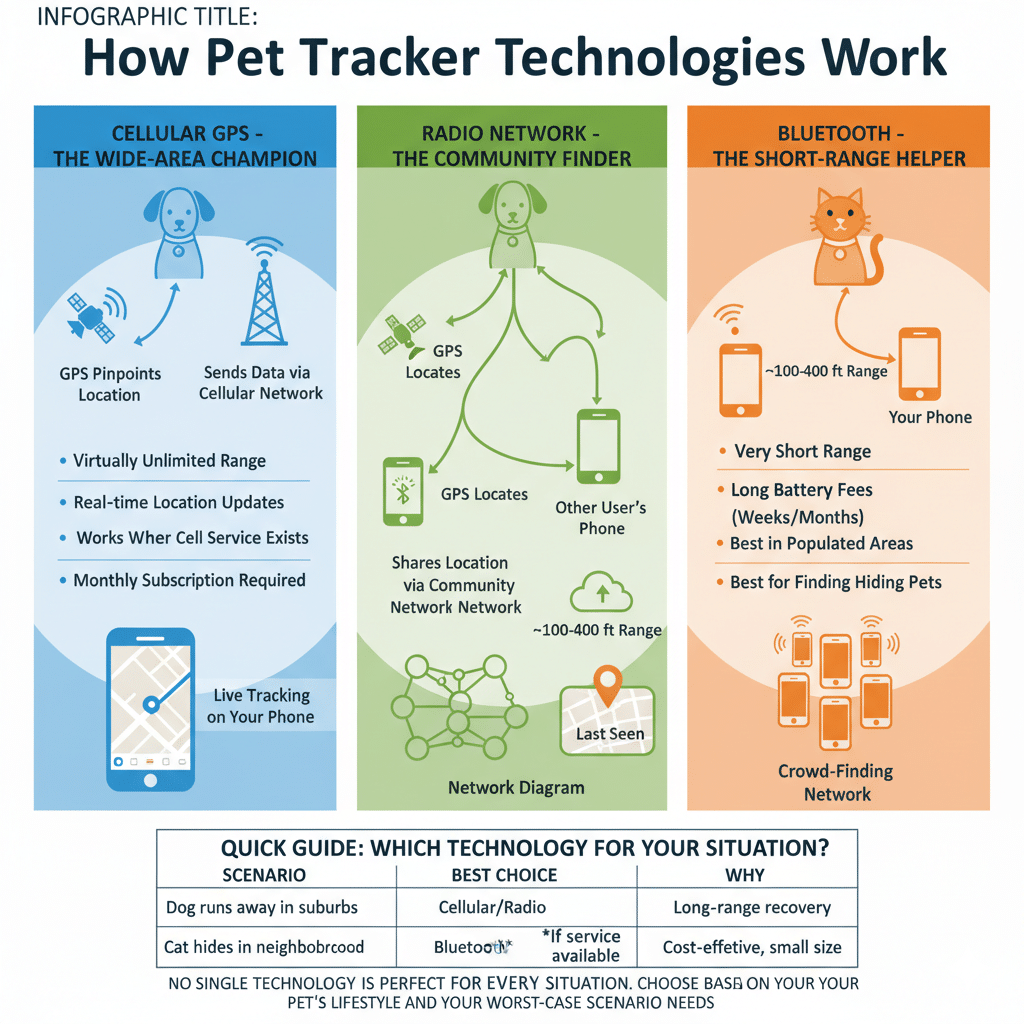
Affiliate Disclosure
We participate in Amazon affiliate program, earning fees from qualifying purchases via links at no extra cost to you.
The heart-stopping panic of a lost pet is a feeling no owner wants to know. A pet GPS tracker is one of the best ways to get that “peace of mind” feeling back. But when you start shopping, you’re hit with a wall of tech jargon: Cellular, LTE-M, Radio, Bluetooth.
What does it all mean? And more importantly, which GPS pet tracker technology will actually bring your furry friend home?
This isn’t just a list of products. This is a plain-English guide to the technology inside them. We’ll break down how Cellular, Radio, and Bluetooth pet GPS trackers work, where they excel, and where they fail. Let’s find the perfect tech for your pet’s lifestyle.
Related: Top 10 Luxury Pet Tech Gadgets of 2025
At a Glance: Pet Tracker Technology Showdown
| Feature | Cellular GPS Tracker | Radio GPS Tracker | Bluetooth Tracker |
|---|---|---|---|
| How It Works | Uses cell towers (like your phone) | Uses a proprietary radio network | Uses nearby smartphones |
| Best For | Wide-area escape, travel | Long battery life, suburban escapes | Finding keys & items in the home |
| Typical Range | Virtually Unlimited (with cell service) | 1-5 Miles (open area) | 100-800 Feet |
| Battery Life | Days to a week (requires charging) | Weeks to months (long battery life) | Months to a year (replaceable battery) |
| Real-World Cost | Device + Monthly Subscription | Device + Annual Subscription | Low one-time cost |
Pet Tracker Technology Infographic

1. Cellular GPS Trackers: The Wide-Area Champions
How It Works: Think of this pet GPS tracker as a tiny, rugged smartphone for your pet’s collar. It contains a GPS chip to pinpoint location and a cellular modem (often on efficient networks like LTE-M) to send that location data to your phone. It needs a monthly subscription to access the cellular network, just like your phone plan.
This is the most powerful and comprehensive type of pet GPS tracker on the market. Brands like Tractive and Whistle use this technology.
Pros and Cons of a Cellular Pet Tracker
Pros:
✔️ Live Tracking & Unlimited Range: This is the biggest advantage. You can see your pet’s location moving on a map in real-time, whether they’re across the street or across the county. This GPS pet tracker provides true peace of mind for a serious escape.
✔️ Virtual Fence & Activity Monitoring: Most cellular models let you set “safe zones.” You get an instant alert if your pet leaves that area. They also double as advanced activity monitors, much like a Fitbit for your dog.
✔️ Works Almost Anywhere: As long as there’s a cellular signal (and specifically LTE-M coverage, which is excellent in most populated areas), this pet GPS tracker will work.
Cons:
❌ Requires a Monthly Subscription: This is an ongoing cost that can add up over time. There’s no way around it.
❌ Shorter Battery Life: Because GPS and cellular radios are power-hungry, these devices often need charging every few days to a week.
❌ Signal Dependent: It won’t work in remote areas with zero cell service, like deep in the wilderness.
Real-World Scenarios: Is a Cellular Tracker Right for You?
- The Suburban Escape Artist: PERFECT. If your Houdini dog digs under the fence, a cellular GPS pet tracker lets you see exactly which yard they’re in and chase them down in real-time.
- The Adventure Hiking Dog: GOOD, with a caveat. It’s great on popular trails with service. But if you’re deep in a national park with no towers, you’ll lose tracking. Always have a backup plan.
- The City-Dwelling Cat: OVERPOWERED & BULKY. The size and limited battery life often make cellular units too big and heavy for most cats.
2. Radio Frequency (RF) Trackers: The Long-Range, Long-Lasting Option
How It Works: This technology is different. A radio pet GPS tracker (like the Fi Series) uses a combination of technologies. It primarily uses GPS and LTE-M to map your dog’s location, but the unique part is how it communicates that location to you.
When your dog is lost and out of your phone’s Bluetooth range, the tracker switches to a decentralized “Find My”-style network. It sends its location to the app via LTE-M when it detects another Fi user’s device nearby. This “community find” network is its secret weapon in populated areas.
Pros and Cons of a Radio Pet Tracker
Pros:
✔️ Excellent Battery Life: By being smarter about when it uses power-hungry GPS, radios like the Fi can last for weeks or even months on a single charge.
✔️ Community Find Network: This is a game-changer. If your dog gets lost in an area with other users, the network can help find them even if you’re miles away.
✔️ Great for Suburban & Semi-Rural Areas: It offers a powerful blend of long-range and long battery life, perfect for dogs with large yards or who explore on rural properties.
Cons:
❌ Limited “Live” Tracking: Most don’t offer true, continuous live tracking like a dedicated cellular unit. They update location periodically or when a specific event (like leaving a safe zone) occurs.
❌ Network Reliance: The “community find” feature is most powerful in areas with a high density of other users. It’s less effective in very remote locations.
❌ Subscription Required: Like cellular models, it requires an annual or monthly plan to access the network.
Real-World Scenarios: Is a Radio Tracker Right for You?
- The Suburban Escape Artist: EXCELLENT. The long battery life and community network are ideal for a dog that might roam a few neighborhoods away.
- The Adventure Hiking Dog: GOOD. The long battery is a major plus for multi-day trips. However, its effectiveness depends on other hikers in the area also using the same brand.
- The Country Dog on a Farm: GREAT. A radio pet GPS tracker can handle the large, open spaces and provides location updates without needing constant charging.
3. Bluetooth Trackers: The “Find Your Keys” Tech
How It Works: Let’s be clear: a Bluetooth tracker (like an Apple AirTag or Tile) is NOT a true GPS pet tracker. It has no GPS or cellular connection. Instead, it uses short-range Bluetooth to connect to your smartphone. When your pet is lost, it relies on being within ~100 feet of any smartphone running the Find My network (for AirTag) or the Tile app.
Pros and Cons of a Bluetooth Pet Tracker
Pros:
✔️ Very Low Cost & No Subscription: The device itself is cheap, and there are no ongoing fees.
✔️ Tiny and Lightweight: This is the only type of tracker small and light enough for most cats and small dogs.
✔️ Long Battery Life: A single battery can last a year or more.
Cons:
❌ Extremely Short Range: This is the biggest limitation. A Bluetooth tracker only works if your pet is very close by. It’s useless if they’ve truly run away.
❌ No Location History or Live Tracking: You can’t see where they’ve been or where they are on a map. You can only play a sound when you’re close.
❌ Passive Finding: It doesn’t actively help you. You have to be within range, or hope that someone else with the right smartphone walks near your lost pet.
Real-World Scenarios: Is a Bluetooth Tracker Right for You?
- The Suburban Escape Artist: NOT RECOMMENDED. If your dog runs away, a Bluetooth tracker offers little to no help in finding them.
- The Adventure Hiking Dog: USELESS. There will be no other smartphones around to detect the tracker in the wilderness.
- The City-Dwelling Cat or Apartment Dog: HAS A NICHE. It can help you find a cat hiding under the neighbor’s porch or in a nearby basement. It’s better than nothing, but it’s not a true safety solution for escape.
The Final Verdict: Which Pet Tracker Technology is Safest?
So, which pet GPS tracker should you buy? The answer depends entirely on your worst-case scenario.
For Ultimate Safety & Peace of Mind:
Choose a Cellular or Advanced Radio Tracker. If your biggest fear is your pet bolting out the door and disappearing, you need the unlimited range of a cellular GPS pet tracker or the community-powered network of a radio model. This is the only technology that gives you a real chance of recovery from miles away.
For Battery Life & Suburban Roaming:
Choose a Radio Tracker. If you have a dog that explores a large property and you want to avoid weekly charging, a radio pet GPS tracker like the Fi Series offers a fantastic balance of range and battery longevity.
For Finding a Hiding Pet, Not a Lost One:
A Bluetooth Tracker can be a supplement, not a solution. It’s perfect for the cat who loves to hide inside the house or the dog who might be napping in a hidden corner of the backyard. Never rely on a Bluetooth tracker as your pet’s primary safety device.
The bottom line: Your pet’s safety is priceless. Investing in the right pet GPS tracker technology for their specific lifestyle is one of the smartest decisions a pet parent can make. For most dogs, that means a Cellular or Radio model. For city cats, the choice is harder, but a Bluetooth tag can offer a tiny bit of extra help.










